
19 October 2019
A & E attendances – Twice as high for people from the most deprived areas compared to the least deprived.
There were more than twice as many attendances, 3.1 million, for people living in the 10% most deprived areas of the country compared to 1.5 million for those living in the 10% least deprived areas of the UK (2018-19).
The figures, produced by NHS Digital Hospital Accident and Emergency Activity 2018/19 also shows that attendances from all types of Accident and Emergency attendances, by those living in the 20% most deprived areas, accounted for 27% of total attendances.
The NHS’s data shows
- Monday is the busiest day of the week and the most popular time of arrival is between 10.00 am and 12.00 noon
- The number of reattendances to A and E within 7 days was 1.9 million accounting for 8.7% of all reported attendances.
- Patients arriving between 8.00 am and 10.00 am generally spent the shortest time waiting in A and E with 16% of patients arriving between 8.00 am and 9.00 am spending 1 hour or less, and 90% of arrivals between 9.00 am and 10.00 am spending 4 hours or less.
- 1.5%, 330,000 people, spent more than 12 hours in A and E in 2018/19, an improvement from the figures for the year previous 1.6%, 333,000.
- There was a 4% increase in attendance at A and E during 2018/19 (24.8 million), compared to 2017/18 (23.8 million) and a 21% increase since 2009/10 (20.5 million).
- The average growth per year is 2 per cent, compared to the growth in the population of 1% per year.

Q. This rate of increase clearly cannot carry on indefinitely without placing too great a strain on our overstretched A and E Departments
A. The Government are trying hard with alternative providers of initial help and advice, e.g. telephone helplines to try to encourage people only to go to A and E when absolutely necessary
Q. Should people be charged a fee for attendance at A and E, subject to waivers for those on limited means?
A. A very hot political potato. The increases in the figures would suggest that some attendances may be unnecessary, but a charge may discourage genuine attendances.
Q. Why is there a relation to the areas people come from?
A. Maybe the message of helplines etc is just not getting through to the whole population.


